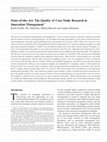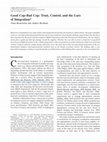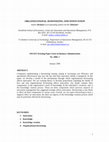Papers by Anders Richtnér

Journal of Product Innovation Management, 2019
The practice of innovation management is developing fast. As new concepts emerge, exploratory stu... more The practice of innovation management is developing fast. As new concepts emerge, exploratory studies are needed and case study research is often appropriate. To investigate the usage and quality of case study research in innovation management, all of the articles published in five top journals over 20 years (1997-2016) were reviewed. Case study research accounted for 818 of the published articles in this period (12%) and an evaluation template (termed case study evaluation template: CASET) was developed to objectively assess these articles against 10 quality criteria. It was found that the quality of case study research has often been low, although it has improved over time. Similarly, quality was found to fluctuate both within and between the different innovation journals. This indicates that the peer review process for case study research is not as robust as it should be. The assessment of individual articles using the evaluation template found significant deficiencies. Many articles: did not justify why case study research was appropriate; did not apply theoretical sampling criteria; were not transparent on how conclusions were drawn from the data; did not consider validity and reliability adequately; and did not go beyond description in their interpretation. However, the evaluation template also identified 23 "exemplary studies," which clearly addressed nearly every criterion. Such exemplary studies provide innovation management researchers with "bench-mark" reading, which can help shape their own research. This article makes four contributions to the innovation management discipline. First, the evaluation template and exemplary studies can help innovation researchers improve the quality of their case study research. Second, clear recommendations are given for how reviewers can use the template to make the peer review process more consistent and robust. Third, journal editors are encouraged to consider the implications of the findings for their particular journal. Fourth, the article should stimulate a long overdue debate on methodology in innovation management research, including the use of case study research.
Programs to decrease cost and to increase operational efficiency may reduce a company's abili... more Programs to decrease cost and to increase operational efficiency may reduce a company's ability to innovate, by reducing organisational slack. Previous research on the relationship between organisational slack and innovation has been at level of the firm and has neglected the processes underlying the relationship, which takes place at the level of product development projects. In this paper, we identify
International Journal of Innovation Management, 2015

International Journal of Innovation Management, 2015
ABSTRACT Research on knowledge transfer has predominantly focused on how to transfer source knowl... more ABSTRACT Research on knowledge transfer has predominantly focused on how to transfer source knowledge successfully to a recipient. However, there is a lack of studies on product development (PD) collaborations where the parties involved in the knowledge transfer must all jointly contribute to the knowledge transfer process when no clear sender–receiver relationship exists. Our paper concerns these relationships and is guided by the following research question: What are the mechanisms used in order to create operational level conditions for knowledge transfer in collaborative PD projects? Through a three-year longitudinal inductive case study on knowledge transfer between two companies, covering both operational and managerial levels, five key mechanisms for enabling knowledge transfer were identified: (1) co-locate a team; (2) access to existing technology; (3) establish a common vocabulary; (4) shared work processes; and (5) having joint work tasks. Our results show these five mechanisms have a mutual influence on each other, thus further facilitating the transfer of knowledge. Understanding the mechanisms and their interplay can help companies succeed in their attempts at reaping the benefits of PD collaborations.
Research Policy, 2012
... necessarily stimulate creativity. This finding complements earlier studies arguing for a rela... more ... necessarily stimulate creativity. This finding complements earlier studies arguing for a relationship between trust and creativity ( [Bidault and Castello, 2009] , [Bidault andCastello, 2010] and [Chen et al., 2008] ). Fourth, by introducing ...
ABSTRACT Our concern is with how interaction with customers affects knowledge creation in product... more ABSTRACT Our concern is with how interaction with customers affects knowledge creation in product development projects. Customers have a crucial role in stimulating innovation, but previous research has not identified what effects the interaction has on knowledge creation nor at what point in time interaction with customers should be sought. Through case research in high velocity industries we identify the effect customer interaction has on knowledge creation processes inside new product development projects and therefore ultimately innovation. In particular we highlight the effects the interaction has on tacit and explicit knowledge, and the need to acknowledge the difference between the two.

Journal of Product Innovation Management, 2014
Based on a longitudinal case study of four interorganizational product development collaborations... more Based on a longitudinal case study of four interorganizational product development collaborations, this paper identifies a lure to cross-functional integration that has hereto been neglected. In particular, findings suggest that when the buyer firm separates the Research and Development (R&D) Department from the Procurement Department, the two departments play a good cop-bad cop strategy toward the supplier. Thereby, they are able to foster a high level of goodwill trust between R&D personnel of the collaborating firms, while procurement personnel maintain a high level of formal control. Using an intricate sample design with polar cases, the study shows that cross-functional integration of the two departments hampers interorganizational goodwill trust at the benefit of formal control. The findings offer a way forward for managers seeking to reap the benefits of collaboration, while limiting their exposure to the associated risks.
Journal of Product Innovation Management, 2013
During new product development (NPD), functional areas such as marketing, R&D, and manufacturing ... more During new product development (NPD), functional areas such as marketing, R&D, and manufacturing work together to understand customer needs, create product concepts, and solve technical issues. NPD is dependent on the creation of new knowledge and the interplay between tacit knowledge (knowledge that is difficult to articulate and codify) and explicit knowledge (knowledge that can be codified and documented). Knowledge creation requires time and resources, and the dichotomy facing senior management is how much spare capacity in NPD teams-so-called organizational slack-is appropriate. Too much organizational slack and precious development resources will be wasted; but when slack is eliminated, there is a danger that knowledge creation will be severely hindered.
International Journal of Innovation Management, 2006
Programs to decrease cost and to increase operational efficiency may reduce a company&amp... more Programs to decrease cost and to increase operational efficiency may reduce a company's ability to innovate, by reducing organisational slack. Previous research on the relationship between organisational slack and innovation has been at level of the firm and has neglected the processes underlying the relationship, which takes place at the level of product development projects. In this paper, we identify
European Journal of Innovation Management, 2008
Purpose – This paper aims to highlight that there are different levels of analysis and that there... more Purpose – This paper aims to highlight that there are different levels of analysis and that there are different types of influence on the choice of R&D location and organization. Specifically, the purpose of the paper is to identify geographically dispersing and contracting forces on R&D activities, which helps bring together these two theoretical fields. Design/methodology/approach – A case study
Creativity and Innovation Management, 2010
Our concern is with how changes in organizational slack affect knowledge creation in product deve... more Our concern is with how changes in organizational slack affect knowledge creation in product development projects. We operationalize a change in organizational slack as changed possibilities to depart from project deliverables in NPD projects. Through case research in high velocity industries we identify the effect a change in organizational slack has on knowledge creation processes inside product development projects. In particular we highlight the effects on tacit and explicit knowledge. More specifically we find that reduced slack creates a focus on explicit knowledge rather than tacit knowledge, which may reduce the ability to create knowledge creation and ultimately to innovate.

SSE/EFI Working Paper Series in …, 2006
Companies implementing a downsizing strategy aiming at increasing cost efficiency and operational... more Companies implementing a downsizing strategy aiming at increasing cost efficiency and operational effectiveness may face the fact that their innovative ability is hampered. In this paper, we develop a model of the mechanisms through which organizational downsizing affects innovation. We use existing theory to develop propositions regarding the details of how and why organizational downsizing affects innovation. Our model contains three components: a) the organization's stock of knowledge, b) the individual's creativity, and c) the knowledge creation process. These are three components which previous research on innovation management has suggested strongly affects innovation. Downsizing is also likely to affect all three components in various ways. Overall, we can expect downsizing to have a negative effect on innovation, but there are aspects of the knowledge creation process which may be positively affected by downsizing.
Purpose – The purpose of this paper is to examine the role of top management control in stimulati... more Purpose – The purpose of this paper is to examine the role of top management control in stimulating innovation through their effect on the creation of knowledge in new product development (NPD) projects. Top management has a crucial role in stimulating innovation in companies, in particular as top managers affect knowledge creation through their interaction with project teams before and
This paper advances the understanding of absorptive capacity by disentangling its four distinct s... more This paper advances the understanding of absorptive capacity by disentangling its four distinct sub-dimensions. Most of the studies in extant literature have treated absorptive capacity as unidimensional concept and as a firm-level construct without paying due attention to its organizational antecedents. Based on the observation that deliberated inter-unit knowledge transfer processes are mostly executed through projects in practice, we suggest that project specific characteristics (i.e., task, time and team) should be considered as salient and relevant antecedents of absorptive capacity. In that regard, we discuss how scope of task, composition of team and perceptions of time have varying and somewhat conflicting effects on acquisition, assimilation, transformation and exploitation dimensions of absorptive capacity.

Uploads
Papers by Anders Richtnér